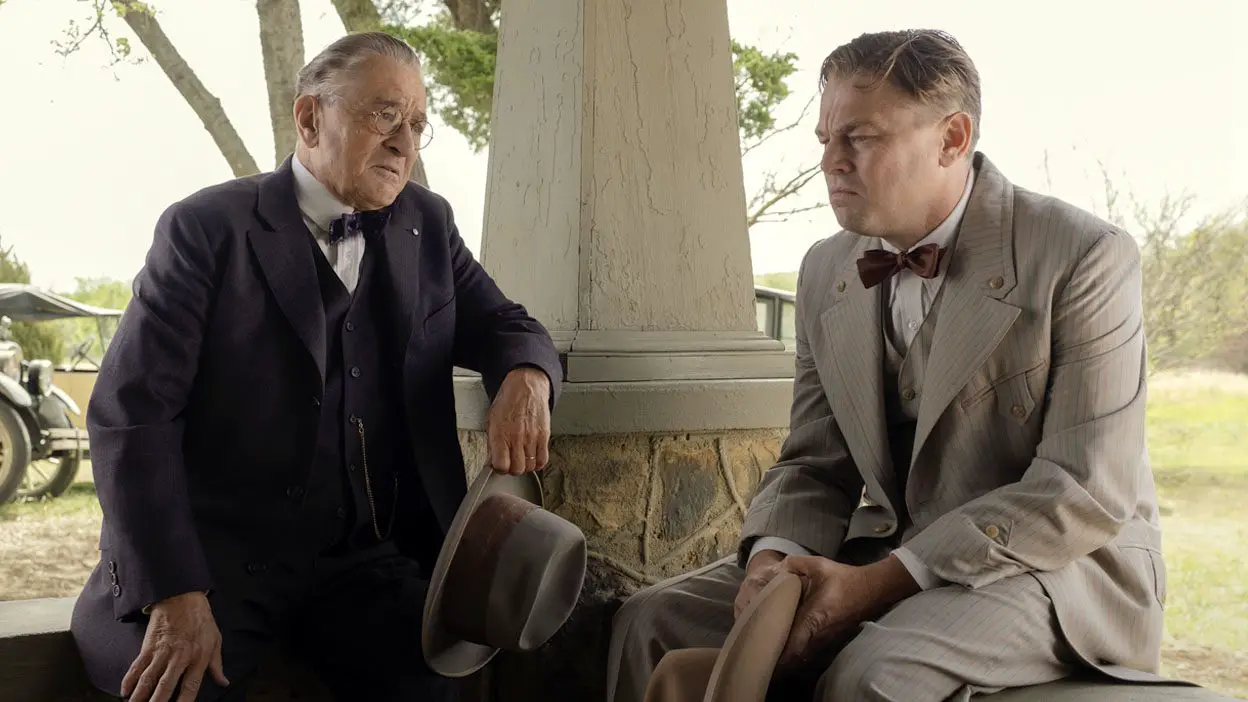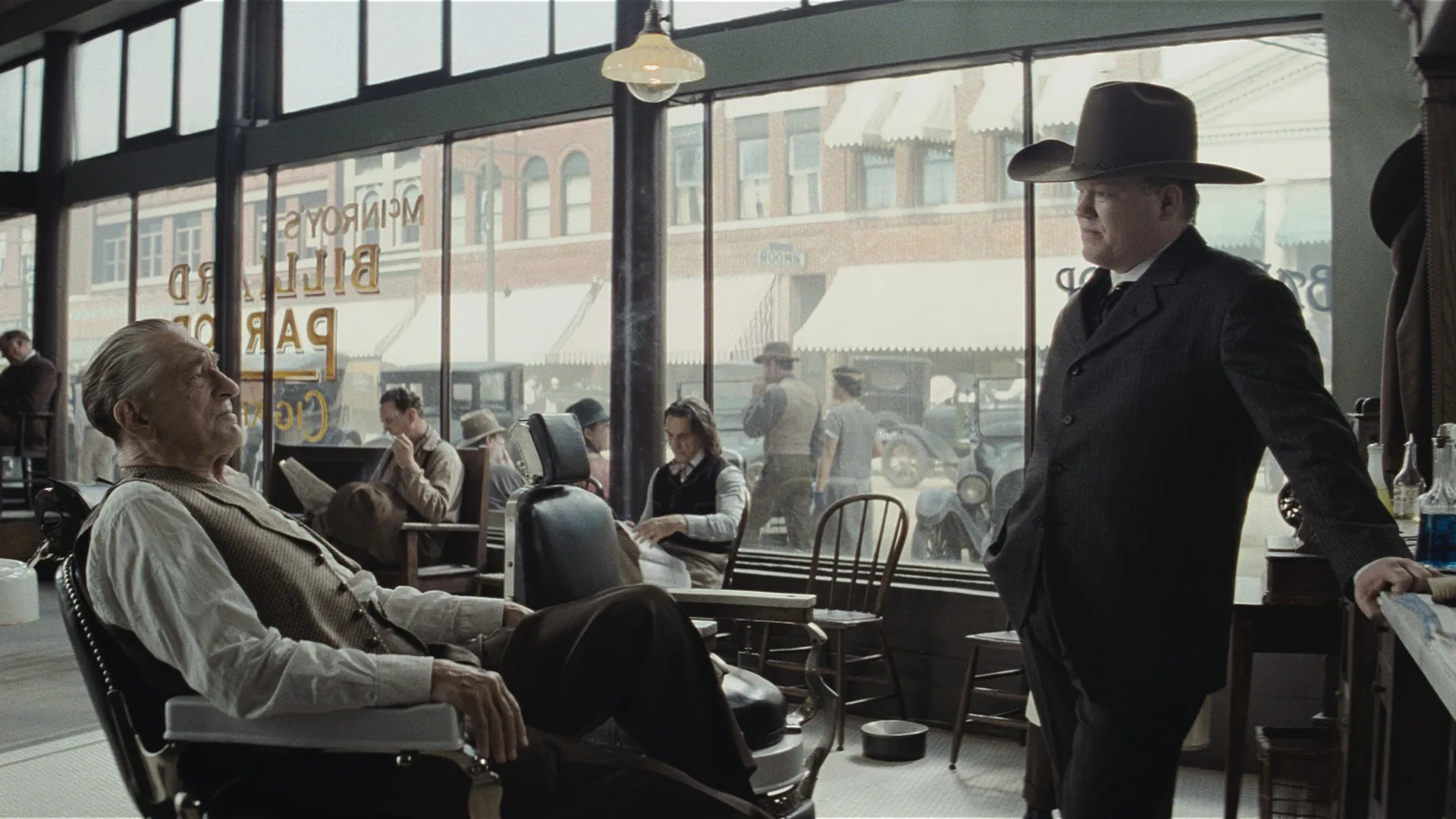Martin Scorsese has wanted to make a western his entire career. And now, with Killers of the Flower Moon, he has finally done so. But it is unlike what he had initially envisioned, and it is better for it, flaws and all.
First things first, whatever you may envision KOTFM to be, it is not. A Sweeping epic? While it may be an epic, it feels meditative and deliberate, with only the barest hints of visual flourishes one might call sweeping.

A brutally violent rendering of how white settlers so casually and maliciously cheated the Indigenous people out of their land and property? Hardly, though, Scorsese and his cameraperson Rodrigo Prieto attempt to show the horrific cognitive dissonance of how people can pretend to be so loving while committing atrocities.
Yet, Scorsese and Roth choose to focus on the women in Mollie’s family to make the film more digestible. But in Scorsese’s attempt at cinematic statesmanship, there’s a lack of rage and poeticness within the film while overlooking the crimes’ grandiosity.
Still, KOFTM showcases the banality of evil with such banal honesty that it is, by design, unsettling. Scorsese and his co-writer Eric Roth have penned one of the more honest westerns not because it depicts the slaughter of innocent Indigenous peoples but because it strips the mythos of the American West of its pretenses and lays bare its genocidal and greedy soul.
Based on the non-fiction book by David Grann, Scorsese and Roth are uninterested in the propaganda aspect of the birth of the FBI. Instead, they are interested in the same thing Scorsese has always been interested in: the story of America and how history is a patchwork of people pursuing the so-called American dream unvarnished, tainted, and riddled with blood and lies.
Throughout KOFTM, characters like Robert DeNiro’s William Hale talk about how the Osage people didn’t earn their money. They didn’t deserve it because they didn’t earn it. Contrasted with how other characters describe Hale’s men as lazy and entitled. The Osage people lucked into the oil field; it is theirs by right, but Hale and the other whites can’t stand this and so “rationalize” their heinous acts as “earning it.” His ego is so egregious that Hale demands to be called “King.”
Underpinning all of this is Leonardo DiCaprio’s Ernst Burkhart. Ernst may well be DiCaprio’s most ruthless, violent, and naive character of his career. The least charismatic of the actor’s stable of characters, Ernst “loves money and women,” both of which will be his downfall, and had Ernst been any kind of a human being, one of which could have been his salvation.

In a sense, part of the discomfort from KOFTM is how Scorsese and Prieto’s camera ask for a smidgen of empathy for the deluded, tragic fool. We get the sense that Ernst isn’t quite sure what’s going on, but that’s hardly an excuse when you consider that he begins to poison his wife, Mollie (Lily Gladstone), merely because his uncle told him to.
Gladstone should be a bigger star by now, except we live in the worst timeline. But thankfully, Scorsese has seen fit to make KOFTM somewhat a magnum opus to her talents. While she may have less screen time than DiCaprio, her presence is felt in every scene, haunting the edges as we wonder how much she knows or suspects. She bears the pain of the deaths and the tragedies bestowed upon her people by the Hales of the world. She conveys a multitude of emotions and thoughts by adjusting her blanket, or how she can hold her co-stars in her gaze, so arresting that, if nothing else, KOFTM is a towering testimonial to her talent.
The love between Ernst and Mollie is the driving force of KOFTM and is the other component of what makes the film so unsettling. Mollie loves Ernst, is wary of him, but believes him to be harmless. For his part, Ernst believes he loves Mollie, but the man is so vacuous that it becomes clear that he does not know what love is. The plot of KOTFM is about how a bunch of white men set about a blundering and monstrous killing spree to wed and kill Osage millionaires and steal their land and wealth for themselves.
But the story is the tragic horror cum love story of Ernst and Mollie. Their courtship, marriage, and love make every moment heavy with unbearable heartbreak. Because despite what Ernest or Mollie may believe, Ernst is incapable of love. It is too complex of an emotion for him to understand, yet somehow, we almost feel for him.
DiCaprio’s Ernst is such a galactic lunkhead of such epic proportions that were he, not such a vile man, he would be pitiable. It’s almost comical with one scene that had me laughing as DeNiro’s King realizes that Ernst has no clue what he is talking about despite his presence at every step of the planning process. “Look at me like you know what I’m talking about!”
KOFTM would be a comedy if not a rapacious tale of colonialistic blood lust. Hale, Ernst, Ernst’s brother Byron (Scott Shepherd), and the others are not clever men. To the point that when the FBI finally arrives late in the movie, led by Jesse Plemmon’s Tom White, there’s almost no real investigation needed. Everyone knows what’s happening; none of it is secretive, right down to the KKK marching down the main street during a Veterans Day parade with their hoods up, faces in plain sight.
Scorsese and Prieto eschew subtlety for the simple reason that the Hales and the Burkharts weren’t subtle. One scene has Prieto’s camera dollying through Mollie’s house after she’s married Ernst. We see how her once spacious house with just her and her mother, Lizzie Q (Tantoo Cardinal), is now overrun by Ernst and his family, with his grandparents sneering at their mixed-raced grandchildren and doting on the child with the whiter skin.
A microcosm of the history of oppression not just in America but of history, Scorsese is unflinching in how he depicts the callous violence against the Osage. Contrary to his reputation, the violence in much of Scorsese’s movie is implied. His longtime collaborator editor, Thelma Schoonmaker, edits Scorsese’s films so that the violence is palpable. But she and Scorsese stand back and let the violence play out here. Not to glorify or beautify the maiming of brown bodies but to show the cool and incomprehensible ways the murders were committed. Schoonmaker and Scorsese are unflinching. He will give us a scene of tenderness, such as Mollie and Ernst sitting and watching the storm outside, but cut it short. But the violence, like the instance of the husband who leans out of his house to shoot his wife, is allowed to linger.
Prieto and Schoonmaker work together to ensure the violence is not cinematic and instead perfunctory, almost an afterthought. But by doing this, they create a coldness to KOTFM that I am unsure Scorsese was aiming for. As impressive as the film is, it feels oddly removed from the events even as Scorsese allows us to soak in the details of the time, from the costumes to the sets, and give us a sense of time and place.
Eagle-eyed readers will notice something about my review, and that’s how I’ve focused on the white characters and little on the Osage. The flaw of Scorsese’s KOFTM is how the Osage people feel like a side note. I’m not saying Scorsese ignores or uses them as props; far from it. But because of how Scorsese and Roth frame the narrative, the Osage people and their deaths- while not glorified or exploited-feel kept at a distance.
Perhaps it is merely the limits of whiteness.

Yet, Scorsese allows them an inner life and gives us access to their interior emotions and thoughts. Lizzie Q’s vision as she dies, as well as the Osage council meeting, shows us the rage and pain that consumes them, as it seems the good fortune of finding oil comes with yet another price tag they were unaware of. But it’s moments where Scorsese lingers on DiCaprio’s Ernst’s face as he searches the rubble of the bombed house that killed Mollie’s sister, where we’re asked to sit with his complex feelings, that makes KOTFM uncomfortable.
It’s the uneven balance of perspectives that, despite Scorsese’s steady and sure direction, gives KOFTM a sense of unrecognized grandeur. Perhaps Scorsese is trying to reach for something he can not quite articulate within himself while attempting to unpack a genre and art form he has loved for most of his life.
To an extent, Scorsese realizes this. The epilogue to KOFTM seems almost to comment on cinema’s limits as a tool for historical documentation and a propaganda machine to ease white consciousness. The film, so steeped in realism, can be jarring at times when Scorsese flirts with hints of dream-like imagery. Scenes such as Ernst’s visions of the flames engulfing his uncle’s farms as he realizes that he’s created this hell.
For the epilogue, KOTFM cuts to a 1950s radio play being performed before a live studio audience. The show is called “Real Life FBI Stories” and is inspired by the real-life copganda radio shows of the time. The all-white cast, none of which are from the film, proceed to tell us what happened to the “characters,” all while being sponsored by the cigarette company Lucky Strike. Any director would give us in text or a montage with text, Scorsese acts out, smashing the fourth wall and acknowledging that all that has come before was merely a re-enactment that is hobbled by the impossible task of encompassing the real horrors of the events.
The audience claps and laughs, but then Scorsese approaches the microphone to read Mollie’s actual obituary. It is a solemn reading and perhaps the most personal moment of the storied director’s career. Afterward, he looks up and says to the camera, “There was no mention of the murders.”
Schoonmaker then cuts to a tribal drum as Prieto’s camera pulls up as Scorsese reveals the Osage tribe dancing, a show of defiance of centuries of the white man trying to erase them from the land. I don’t think there has ever been such an open admission by a director of the limits of the cinema as well as the power of it than in this moment.
Parallel this moment with how Scorsese shows the footage of the Tulsa riots inspiring Hale’s attempt to wipe out the Osage, and you have a director admitting the power and limits of the form. It can inspire but also seduce a population to believe the lie instead of the truth. But Scorsese’s line at the end holds the most power: “There was no mention of the murders.”
Every day, there is a news story of school boards banning books from libraries and sanitizing history to avoid offending white children. It’s easy to ignore the truth and print the legend. But at what cost?
Scorsese only briefly mentions the land conservatorships and hints at the staggering number of murders. By making it seem that the whites like Hale are jealous of the Osage’s wealth, despite their own comfortable fortunes, he overlooks the way the Osages, even with the wealth, had no real power over their so-called fortunes.
Killers of the Flower Moon wrestles with film history and America’s; sometimes, it comes up short. But in Scorsese’s hands, there’s sincerity and a clear-eyed vision that refuses to buckle simply because achieving it may be too difficult.
Images courtesy of Apple Original Films, Apple TV+, Paramount Pictures
Have strong thoughts about this piece you need to share? Or maybe there’s something else on your mind you’re wanting to talk about with fellow Fandomentals? Head on over to our Community server to join in the conversation!

